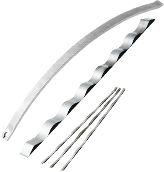- keyword
- servicelife
- extensionsprings
- springshook
- machinehalfhook
- machinehook
- stressconcentrationcoefficient
Question TETSU 2006/2/13(Mon) 2:54
Hello, I have been learning a lot from your company’s page, and thank you very much for that.
I have two questions that need your help.
Question 1: Regarding the machine half hooks and the machine hooks of extension springs, what are the advantages of each? (it seems like there are more springs in the world with machine half hooks.)
Question 2: Generally, if the diameter of the hook part is not smaller than that of the body part, the hook part will have a shorter service life. This is due to the stress concentration coefficient on the technical information page, isn’t it? I think that r1 and r2 in this figure are the values in the full stroke state. Please tell me the calculation method (calculation formula) of these values. (If possible, I would like the formula that includes the inner diameter of the hook.)
If it is not okay to publish it in the comment, you can send it directly to the above e-mail address. I look forward to your reply.
Answer Tokai Spring 2006/2/13(Mon) 15:32
Thank you for writing to us, TETSU!
Regarding the hook shape of the tension coil springs, machine hooks and half machine hooks are commonly used, but the machine half round hooks are more suitable for automatic forming of cold-formed springs using thin wires. Because the hooks are pulled out from the center of the coil, they have excellent stability. Since the breakage of the tension springs is more often caused by the stress concentration of the hooks rather than the coil part, therefore, it is necessary to increase the radius of curvature of the part rising from the coil part to the hook to avoid stress concentration and prevent scratches from machining.
About the calculation formula, we will send you the material directly!
We are happy to answer any inquiries regarding technology, specifications, materials, etc. Please feel free to ask.

















